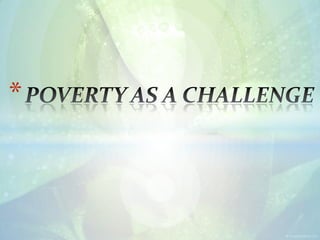
poverty as challenge
- 1. *
- 2. * Poverty is about not having enough money to meet basic needs including food, clothing and shelter. However, poverty is more, much more than just not having enough money. The world bank describes poverty as: “Poverty is hunger. Poverty is lack of shelter. Poverty is being sick and not being able to see a doctor. Poverty is not having access to school and not knowing how to read. Poverty is not having a job, is fear for the future, living one day at a time.”
- 3. * *Under Relative poverty the *Absolute poverty refers to the economic conditions of different measure of poverty , keeping in regions or countries is compared. view the per capita intake of The capita income and the calories and minimum level of national income are the two consumption . indicators of relative poverty. According to the UNO those *Per capita income : countries are treated poor whose National income per capita income is less than Population US $725 per annum.
- 4. *Under this the minimum food *This method is used by the requirements for survival is government while distributing estimated. food through PDS at the local *The food value is converted into level. calories. *Under this a poverty line is * *The caloric value of food is then converted into the money value fixed by the government. *All the families whose total i.e. in rupees. income is less than the poverty *The total equivalent amount is line fixed by the government are considered as the poverty line. considered as BPL.
- 5. * *Poverty line is the line which indicates the level of purchasing power required to satisfy the minimum needs of a person. It represents the capacity to satisfy the minimum level of human needs. The line divides the people into 2 groups : 1. Above poverty line 2.Below poverty line
- 6. * Poverty and occupation both are co-related. Most of the poor people include agricultural and casual laborers, the SCs , STs and the physically challenged. 60 Poverty in India 2000 : Most vulnerable 51 50 47 50 Group 43 40 30 26 20 10 0 Sheduled Urban Rural Sheduled Average Tribes Casual Agricultural Castes Indian Labourers Labourers Poverty Ratio
- 7. * * BRITISH RULE * RURAL ECONOMY * HEAVY PRESSURE OF POPULATION * CHRONIC UNEMPLOYMENT AND UNDEREMPLOYMENT * LACK OF PROPER INDUSTRIALISATION * SOCIAL FACTORS * INDIA’S ECONOMIC POLICY * NEO-LIBERAL POLICIES AND THEIR EFFECTS
- 8. * STATES No. Of People BPL % of People BPL BIHAR 425.64 42.60 MADHYA PRADESH 298.54 37.43 MAHARASHTRA 227.99 25.03 ORISSA 169.09 47.15 TAMIL NADU 130.48 21.12 UTTAR PRADESH 529.89 31.15 WEST BENGAL 213.49 27.02 GOA 0.70 4.40 GUJARAT 67.89 14.07 HARYANA 17.34 8.74 HIMACHAL PRADESH 5.12 7.63 JAMMU & KASHMIR 3.46 3.48 KERALA 41.04 12.72 PUNJAB 14.49 6.16
- 9. * *Swarna Jayanti Gram Swarozgar Yojana (SGSY) *Sampoorna Gramin Rozgar Yojana (SGRY) *Prime Minister’s Rozgar Yojana (PMRY) *Swarnajayanti Shahari Rozgar Yojana (SSRY) *Pradhan Mantri Gramodaya Yojana (PMGY) *National Rural Employment Guarantee Act (NREGA)
- 10. *
- 11. THANK YOU *
